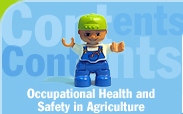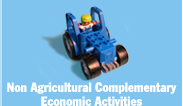PART III. CHOOSING SPRAYING
AND CLEANING STRATEGIES
A.
The basics
When choosing your spraying and cleaning strategies you need to
bear in mind:
-
How the spraying chemicals will be stored and disposed of
-
How your equipment and storage areas will be cleaned
-
What will happen to the run-off from the cleaning process
Some sprays will require you to use more protection than others,
but there are some general principles that apply to all sprays.
Some useful guidance is given in section 3.3 for pesticide
sprays. Remember, a proper clean up of the spray equipment
and disposal of the chemical containers can be just as important
for your safety as the use of protective equipment when
spraying.
The spray that you will use will clearly depend on your crop(s)
and any livestock that you keep on the farm. It is
important to read the MSDS for the sprays and to identify which
sprays for your crop are safe to use when livestock (or working
animals) is nearby, or what steps you must take in order to
protect them. Remember sprays can be carried on the wind
for a considerable distance and so it is essential that you
understand the MSDS information fully before spraying. The
MSDS will have a contact phone number if you need help in
understanding the information presented, or if you have
questions about the use of the spray that are not covered in the
information provided.
You also need to consider the implications of storing the spray
chemicals on your farm and where that can be done safely.
Some guidance is given on this in section 3.2.
B.
Farm chemicals: Storage and Disposal
Stored farm chemicals can cause injury or harm if spillages
occur, containers leak, labels fall off, and untrained people
including children have access to storage areas. Transport of
chemicals, and disposal of chemical containers and other wastes,
pose separate hazards which can also affect the environment.
 Spot
the hazard Spot
the hazard
Read and follow labels and MSDSs (material safety data sheets)
for information on hazards, personal protective equipment, and
safe handling, transport, storage and disposal for each
chemical. Ensure chemicals are stored in a lockable, well lit
and well ventilated area, separated from other chemicals that
may cause them to react dangerously. Be aware that solvents in
some chemical concentrates can escape as harmful vapours unless
containers are well sealed.
Assess the risk
For each chemical hazard identified, assess the likelihood of an
injury, harmful reaction or a hazardous incident occurring.
Assess also whether any injury or harm is serious and imminent,
and whether steps to minimise or eliminate the risk should be
taken immediately. Consider proposed control measures for their
likely effectiveness.
Make the changes
Here are some ways of improving safety in the storage and
disposal of farm chemicals.
-
Store chemicals in a well ventilated and well lit shed that is
lockable and has an impervious floor and impervious shelving.
-
Storage sheds must not be in flood areas.
-
Check the label for advice about storage.
-
Store away from respirators, and other protective clothing and
equipment.
-
Keep pesticides separate from animal feeds, fertilisers, seeds
and other chemicals.
-
Ensure appropriate materials are located close by to clean up
any spills. These may include soil, water, absorbent pillows,
lime or sand.
-
Store the chemicals in the original containers with labels
intact. If labels come off, always re-label the container.
-
Never store chemicals in food or drink containers.
-
Keep incompatible chemicals separated.
Disposal
-
Check the label for advice on disposal of chemicals or
containers.
-
Triple rinse empty containers to remove all traces of the
chemical.
-
Uncap, puncture and crush all rinsed containers.
-
Where possible, return containers to the manufacturer or
supplier, or
-
Ask your local government about its requirements for disposal.
Transport
-
Avoid transporting chemicals with food, water, animal feed or
other reactive hazardous substances.
-
Secure hazardous substances on the vehicle so they can't move
or fall.
-
Keep a record of the chemicals you are carrying.
-
Carry suitable personal protective equipment, including
respiratory equipment if necessary, in case of emergency.
Care for the environment
-
Observe any warnings on the label regarding toxicity to
non-target areas (animals or plants).
-
Contact your local government authority for information on the
procedures for safe disposal of containers or remaining
chemicals.
C.
Safe Use of Farm chemicals: Pesticide Sprays

Most pesticide sprays are hazardous, and can cause injury or
harm if not handled and applied correctly. Use them in
accordance with labels supplied on containers, and with the more
detailed material safety data sheets (MSDSs), available from
your supplier.
Spot the hazard
Read labels and MSDSs carefully. Check spray equipment, safe
handling procedures, protective equipment, operator training and
awareness, and supervision of new and young workers.
Be aware pesticides enter the body through:
-
absorption through skin contact, specially the eyes;
-
inhalation of fumes, vapours and dusts;
-
accidental swallowing while eating, drinking or smoking.
Assess the risk
Assess the effectiveness of protective equipment, decanting,
spray and washdown procedures, operator training and safe
practices. Assess also the likely risk of contamination or
poisoning occurring, and the severity of harmful effects to the
operator. Finally, assess the effectiveness of proposed new
safety measures.
Make the changes
Here are some ways of improving farm spray safety:
-
Use the least toxic pesticide available for effective control
of insect, fungus or plant, as the case may be.
-
Ensure only the recommended rate of pesticide is used.
-
Wear protective clothing and equipment as described on the
label and MSDS.
-
Prepare only enough chemical for immediate use.
-
Keep a record of each use and the results.
-
Ensure equipment works properly and does not leak.
-
Cover feed and water containers near areas where livestock are
grazing;
-
Don't eat, drink or smoke while pouring, mixing or spraying.
-
Don't pour concentrated pesticide into tanks above shoulder
height.
-
Avoid working alone if you are using a highly toxic pesticide;
or have some form of mobile communication.
Spraying
-
Spray with minimal drift and preferably in low wind
conditions.
-
Never spray in high wind conditions.
-
Use mechanical suction to transfer pesticides to spray tank.
-
A vortex system can be used to mix pesticide concentrate with
water before filling the spray tank.
-
Prevent nozzles blocking by using correct filters and
pesticide formulation. Ensure water and equipment are clean.
-
Clear blocked nozzles by using a soft bristle brush or
compressed air. Never suck or blow nozzles to clear them.
Clean up
-
Thoroughly clean all spraying and protective equipment, where
run-off will not create a hazard or contaminate the
environment.
-
Wash work clothing separately from domestic clothing, or use
disposable clothing.
-
Wash yourself well after a spray operation.
-
After handling pesticides, wash hands with soap and water
before eating, drinking, going to the toilet or smoking.
Take precautions
-
Provide a first aid kit that includes a towel, clean clothing,
a resuscitation mask for expired air resuscitation, disposable
eye wash bottle and eye wash solution, soap, nailbrush, and
clear instructions on what to do with this equipment.
-
Keep fresh water close by for washing.
-
Advise someone where you will be working and how long you
intend to be gone. Otherwise ensure you have a two-way radio
for emergency calls.
-
Have a family member or other person at the farm attend first
aid classes.
-
Check the labels, MSDSs or other safe handling guides for your
pesticides, to ensure you have the correct antidotes,
emergency equipment and facilities required by labels and
MSDSs.
-
Stop work immediately and seek medical attention if there is
any sign of muscular spasm, blurred vision, excessive saliva
or difficulty breathing. Suspect pesticide poisoning with any
of these symptoms.
-
If regularly using pesticides, an annual medical examination
is recommended before and after the spraying season, and more
frequently with some chemicals.
For skin contact:
Wash with soap and water, and rinse with clean water. Remove any
contaminated clothing, and seek medical advice.
For eye contact:
Hold eye open under running water for 15 minutes. Seek medical
advice.
For swallowing:
Ring the Poisons Information Center |











